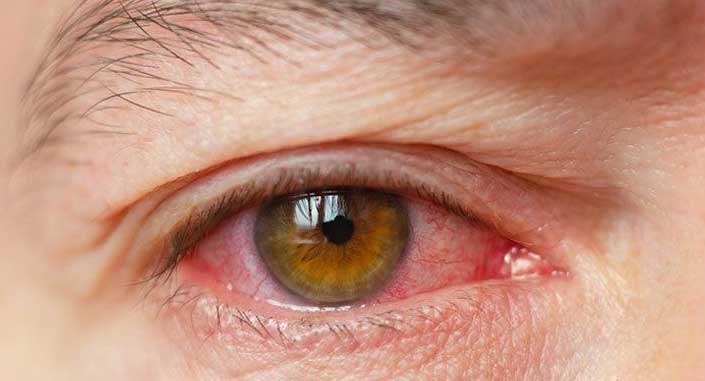If you are suffering from sore, red, gritty, itchy, blurry eyes that are sensitive to light – you might have dry eye disease.
Dry eye disease or ‘dry eye syndrome‘ is a chronic condition that results from insufficient production of tears, when lacrimal glands (in the eyelids) cannot produce enough of the watery component of tears to maintain a healthy eye surface, or because of excessive evaporation of the tear film. This is usually caused by the failure of meibomian glands (in the eyelids) to produce enough of the lipid or oily part of tears that slows evaporation.

Contact lens wearing
Dry or air-conditioned environments
Immune-mediated diseases (such as lupus, rheumatoid arthritis, and sjogren syndrome)
Meibomian gland dysfunction
Vitamin a deficiency
Adverse effects of some medications like antidepressants, antihistamines, and hormone replacement therapy
Eye surgeries, such as cataracts or lasik can cause disbalance in the ocular surface and result in patients experiencing dry eye symptoms. Affected individuals may experience irritation and redness of the eyes, blurred vision, and a feeling of a foreign body inside the eye. When the disease is severe, it can cause damage to the surface of the eye as well as irreversible vision loss and corneal perforation. The effects of dry eye disease can be severe, affecting the quality of life and vision-based activities such as driving and reading.
FIND OUT MORE ABOUT DRY EYE AND WHAT YOU ARE DEALING WITH
Most people with dry eyes experience symptom that include dryness, soreness, burning and sandy-gritty feeling, often described as something that got into the eyes. This causes a tearing reflex and results in watery eyes, although it may seem contradictory. Some will notice a stringy discharge from the eyes.
Other symptoms such as sensitivity to light or blurry vision, can be experienced while participating in activities like reading, using screens, watching tv and driving. This is caused by insufficient blinking, which is necessary to cover the eyes with tears.
If you experience any of the symptoms above for a prolonged length of time, you must consult with a medical professional as soon as possible. Here at eye clinic london, we use non-invasive technology to access meibomian glands in your eyelids enabling us to measure the thickness and structure of the tear film layer and tear break-up time, so that our team can help you with choosing the most suitable treatment for you.
While dry eyes commonly were a problem prevailing in older people, especially women affected by menopause, the covid-19 pandemic and following lockdowns have changed the demographics completely, with an ever-younger population and noticeably more men experiencing dry eye symptoms. Changes in lifestyle such as lack of time spent outdoors, working from home, increased use of screens and even regular use of face masks all contributed to an increased surge in the number of people suffering from dry eyes.
An estimated 344 million people worldwide are affected by this chronic disease. And recent studies by tfos (the tear film & ocular surface society) showed that 1 in 3 people in the uk experiences symptoms of dry eyes.
Although many dry eye sufferers can blame newly adapted changes of lifestyle for the cause of very unpleasant and sometimes painful symptoms of dry eyes, other more serious and complicated underlying health problems can cause dry eye disease.
One of the main causes of dry eyes is meibomian gland dysfunction (mgd) which results in increased evaporation of tear film. This occurs due to the failure of meibomian glands (located in the eyelids) to secrete the oily outer layer essential for sustaining healthy tear film on the cornea of the eye. People diagnosed with mgd often suffer from clogged meibomian glands caused by mild inflammation due to blepharitis or rosacea.
In many other cases, symptoms of dry eye disease are typically caused by decreased tear production, when lacrimal glands in the eyelids don’t produce sufficient amounts of tears to keep the entire cornea of the eye covered. These are often associated with people suffering from sjogren’ syndrome, lupus, rheumatoid arthritis, vitamin a deficiency, trachoma, and other autoimmune diseases.
Certain medications such as:
Antidepressants
Antihistamines
Decongestant
Oral contraceptives
Nasal decongestants
Beta-blockers
Hormone replacement therapy
Can also contribute to decreased tear production resulting in suffering from dry eye symptoms.
Age contributes to the phenomenon of dry eyes in older people, as decreases in tear production are a natural part of ageing.
Additionally, contact lenses are known to absorb natural tears from the eyes leading to dry, sore and burning feelings. Lasik and other refractive surgeries often contribute to developing dry eye symptoms as a consequence of flaps made on the cornea where nerves stimulate tear secretion.
Effectively, environmental factors, such as dry, dusty or smoky places, can worsen or lead to dry eye disease.
Having dry eyes not only can dramatically affect the quality of life but most importantly it can lead to irreversible changes in the ocular surface of the eye, leading to corneal erosions, scarring, corneal ulcerations and corneal perforation and eventually resulting in vision loss
Because of the complex nature of dry eye disease with its multifactorial causes, a series of clinical assessments and diagnostic techniques are performed by our team to diagnose the condition and establish the best management plan for our patients.
Slit lamp assessment is then performed using fluorescence (0.25%) and blue light to assess tear film quality and quantity, as well as observe eyelids, conjunctiva and corneal staining
We offer a wide range of effective dry eye treatments if you are suffering from dry eye symptoms. These may vary from traditional lubricating artificial tears and hot compresses with lid massage to the most efficacious treatment in the latest technology of dry eye treatments
 whatsapp
Clinic
Hospital
whatsapp
Clinic
Hospital